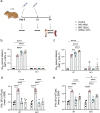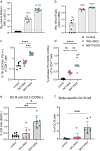Delineation of DNA and mRNA COVID-19 vaccine-induced immune responses in preclinical animal models
- PMID: 38012018
- PMCID: PMC10760386
- DOI: 10.1080/21645515.2023.2281733
Delineation of DNA and mRNA COVID-19 vaccine-induced immune responses in preclinical animal models
Abstract
Nucleic acid vaccines are designed based on genetic sequences (DNA or mRNA) of a target antigen to be expressed in vivo to drive a host immune response. In response to the COVID-19 pandemic, mRNA and DNA vaccines based on the SARS-CoV-2 Spike antigen were developed. Surprisingly, head-to-head characterizations of the immune responses elicited by each vaccine type has not been performed to date. Here, we have employed a range of preclinical animal models including the hamster, guinea pig, rabbit, and mouse to compare and delineate the immune response raised by DNA, administered intradermally (ID) with electroporation (EP) and mRNA vaccines (BNT162b2 or mRNA-1273), administered intramuscularly (IM), expressing the SARS-CoV-2 WT spike antigen. The results revealed clear differences in the quality and magnitude of the immune response between the two vaccine platforms. The DNA vaccine immune response was characterized by strong T cell responses, while the mRNA vaccine elicited robust humoral responses. The results may assist in guiding the disease target each vaccine type may be best matched against and suggest mechanisms to further enhance the breadth of each platform's immune response.
Keywords: COVID-19; DNA vaccines; SARS-CoV-2; animal models; immunogenicity; mRNA vaccines.
Conflict of interest statement
VMA, IM, RK, LJ, OB, LH, and TRFS are employees of and may hold stock options in Inovio Pharmaceuticals., Inc. DWK is the recipient of research funding from Inovio Pharmaceuticals, Inc.
Figures





Similar articles
-
Hybrid Immunity Shifts the Fc-Effector Quality of SARS-CoV-2 mRNA Vaccine-Induced Immunity.mBio. 2022 Oct 26;13(5):e0164722. doi: 10.1128/mbio.01647-22. Epub 2022 Aug 24. mBio. 2022. PMID: 36000735 Free PMC article.
-
Safety and Efficacy of Combined Intramuscular/Intranasal RAZI-COV PARS Vaccine Candidate Against SARS-CoV-2: A Preclinical Study in Several Animal Models.Front Immunol. 2022 May 26;13:836745. doi: 10.3389/fimmu.2022.836745. eCollection 2022. Front Immunol. 2022. PMID: 35693788 Free PMC article.
-
A Single Immunization with Nucleoside-Modified mRNA Vaccines Elicits Strong Cellular and Humoral Immune Responses against SARS-CoV-2 in Mice.Immunity. 2020 Oct 13;53(4):724-732.e7. doi: 10.1016/j.immuni.2020.07.019. Epub 2020 Jul 30. Immunity. 2020. PMID: 32783919 Free PMC article.
-
Severe acute respiratory syndrome-coronavirus-2 spike (S) protein based vaccine candidates: State of the art and future prospects.Rev Med Virol. 2021 May;31(3):e2183. doi: 10.1002/rmv.2183. Epub 2020 Oct 15. Rev Med Virol. 2021. PMID: 33594794 Free PMC article. Review.
-
Nucleic acid-based vaccine platforms against the coronavirus disease 19 (COVID-19).Arch Microbiol. 2023 Mar 30;205(4):150. doi: 10.1007/s00203-023-03480-5. Arch Microbiol. 2023. PMID: 36995507 Free PMC article. Review.
Cited by
-
A comprehensive investigation of Glycoprotein-based nucleic acid vaccines for Hantaan Virus.NPJ Vaccines. 2024 Oct 23;9(1):196. doi: 10.1038/s41541-024-00991-0. NPJ Vaccines. 2024. PMID: 39443512 Free PMC article.
-
An inactivated SARS-CoV-2 vaccine based on a Vero cell culture-adapted high-titer virus confers cross-protection in small animals.Sci Rep. 2024 Jul 24;14(1):17039. doi: 10.1038/s41598-024-67570-0. Sci Rep. 2024. PMID: 39048693 Free PMC article.
-
A comprehensive comparison of DNA and RNA vaccines.Adv Drug Deliv Rev. 2024 Jul;210:115340. doi: 10.1016/j.addr.2024.115340. Epub 2024 May 27. Adv Drug Deliv Rev. 2024. PMID: 38810703 Free PMC article. Review.
-
Guinea Pigs Are Not a Suitable Model to Study Neurological Impacts of Ancestral SARS-CoV-2 Intranasal Infection.Viruses. 2025 May 15;17(5):706. doi: 10.3390/v17050706. Viruses. 2025. PMID: 40431717 Free PMC article.
References
Publication types
MeSH terms
Substances
LinkOut - more resources
Full Text Sources
Other Literature Sources
Medical
Miscellaneous
